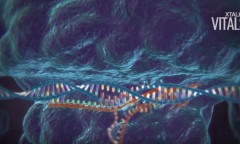By Prei Dy, | March 17, 2017

A team of Chinese researchers tested CRISPR technology on viable human embryos. (YouTube)
Chinese scientists have successfully corrected the genetic information of a normal human embryo using CRISPR technology. This is the first study to describe the results of using the genome editing technique in a viable human embryo.
Although the study has a small sample size - only six embryos - the results suggest that CRISPR works better on normal viable embryos than the non-viable ones, which were fertilized by two different sperms and could never result in a live birth.
Like Us on Facebook
Before experimenting normal ones, studies were focused on using abnormal embryos. However, the experiment only successfully repaired less than 10 percent of genetic mutations, which apparently is too low to be practical but high enough to be encouraging, Fox News noted.
But the Chinese team at the Third Affiliated Hospital of Guangzhou Medical University found a breakthrough when they shifted to repairing mutations in normal embryos from immature eggs donated by people undergoing IVF. Although the eggs presented posed less bioethical problems as IVF clinics usually discard them, such eggs could still produce healthy children.
The team of Chinese researchers intentionally introduced rare genetic disorders to the embryos and attempted to cure the diseases using CRISPR. Scientists found that the CRISPR technology completely, or partially, eliminated the genetic disorders in most of the embryos (three out of the six embryos) that carried them. Such results is deem as promising for experts.
In one of the cases, the CRISPR technique zapped a mutation that caused favism, a condition that causes destruction of red blood cells when fava beans are consumed. The gene-editing tech also fixed the mutation that causes blood disease beta-thalassemia, a rare inherited blood disorder that affects one in every 100,000 people, in another case.
However, the study also highlights a challenge of using gene editing to produce healthy offspring as two of the edited embryos were mosaics, which is a combination of edited and unedited cells. The team injected the CRISPR machinery when the embryos were just single cells; however, in these two cases, repairs were not carried out until they started replicating their DNA.
As a result, some cells inherited unrepaired DNA when they divided. That being said, a problem could arise as this could mean that a child could still develop the disorder the CRISPR was supposed to eliminate. And so far, testing could not determine if the mutation has been fixed.
Meanwhile, the recent breakthrough could eventually lead to more CRISPR gene editing experiments in normal human embryos. However, experts cautioned that the tool is far from the point that it could be safely utilized for editing embryos.
CRISPR, which stands for Clustered Regularly-Interspaced Short Palindromic Repeats, is a technique of disabling genes by introducing small mutations to disrupt the code of a DNA sequence. It allows experts to target a specific sequence of a DNA, remove the genome, and replace it.
-
Use of Coronavirus Pandemic Drones Raises Privacy Concerns: Drones Spread Fear, Local Officials Say

-
Coronavirus Hampers The Delivery Of Lockheed Martin F-35 Stealth Fighters For 2020

-
Instagram Speeds Up Plans to Add Account Memorialization Feature Due to COVID-19 Deaths

-
NASA: Perseverance Plans to Bring 'Mars Rock' to Earth in 2031

-
600 Dead And 3,000 In The Hospital as Iranians Believed Drinking High-Concentrations of Alcohol Can Cure The Coronavirus

-
600 Dead And 3,000 In The Hospital as Iranians Believed Drinking High-Concentrations of Alcohol Can Cure The Coronavirus

-
COVID-19: Doctors, Nurses Use Virtual Reality to Learn New Skills in Treating Coronavirus Patients










